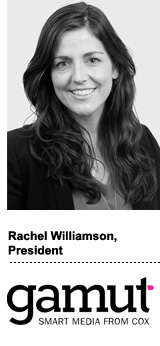
Gamut President Rachel Williamson has two words to describe local over-the-top (OTT) ad buying: “It’s hard.”
Inventory is scattered. Data is fragmented. And advertisers need different strategies to hit different demos based on geography. A buyer might want to reach 34-year-old moms, for example, but that can mean one thing in Birmingham, Ala., and another in New Haven, Conn.
But add enough local media markets together, layer in local data, and you’ve got something like national scale.
Although Gamut, Cox Media Group’s digital media services arm, started out as a programmatic play to help brands deliver cross-channel campaigns across display and mobile, it became abundantly clear roughly three years ago that video needed to become a priority.
Through its OTT product, Gamut Total, the company integrated with national networks, MVPDs and ad-supported networks to access full-episode player inventory, which isn’t always easy for local TV stations to obtain. On the flip side, large agencies work with Gamut to access local audiences via premium content.
“Because we’re a Cox company, we have access to partnerships and clients all over the broadcast and video-buying industry,” Williamson said.
AdExchanger spoke with Williamson about the challenges of local OTT, outcome-based TV campaigns and why CPMs are so variable in over-the-top.
AdExchanger: There are a lot of OTT ad sellers out there these days. What differentiates Gamut?
RACHEL WILLIAMSON: We have custom research and insights to help buyers navigate the local space, a transparent dashboard, and we have our own proprietary platform for local flighting. Most platforms were built for national rather than local, and they do geographical targeting rather think about strategies for individual DMAs.
We also create direct relationships with networks for access to full-episode inventory. You can’t do that through a DSP.
Is scale a challenge for local OTT?
There’s more video viewing today, but it’s scattered across a magnitude of distribution points. That’s why we have direct relationships with networks to get first look at inventory, because you’re not going to find that inventory on the open exchanges, especially in smaller markets. According to FreeWheel, only 14% of inventory is in the open exchange, and that’s inclusive of PMPs.
Who are your clients?
We work with advertisers who see the value in DMA-specific strategies, and that could be anyone from a regional client to a Fortune 500 brand. Around 90% of our clients are from large agencies.
Why is local OTT so tricky to pull off?
You might have millions of dollars spent by one brand, but [it’s spread] over more than 30 DMAs and made up of line items that are in the thousands of dollars range. There’s an art and a science to everything from forecasting to optimization.
OTT dollars are flowing, but what’s stopping spend from really starting to gush?
I see a lot of people in the industry running digital-like targeting meant for a one-to-one mechanism, like mobile. But if you’re thinking about a household, that strategy doesn’t play well. For example, what about co-viewing and trying to understand who is actually sitting in front of the TV on the wall? That’s what the industry is starting to try and solve today, but, of course, they couldn’t start until there was inventory to execute on, which is why we began with that piece.
What do you think about the growing trend of judging TV campaigns based on outcomes?
If the model you’re using for your attribution is sound, outcome-based TV campaigns are great. Accountability is awesome. The problem is that a lot of the outcome-based models you see today, like the ones that look at foot traffic, for example, have very mobile-driven methodologies, and we haven’t figured out how to properly weight an engaged video environment.
I think there should be two attribution approaches – one that’s more DR-focused, and then you’ve always got branding. Premium video is the best branding mechanism out there. There’s not really a banner ad I can think of that’s made me laugh or cry. Video can make you do those things.
But once the methodologies behind outcome-based modeling are correct and we’re measuring things because we should, not just because we can, the industry will be in a great place.
How is OTT inventory priced, and what’s an average CPM?
The challenge in answering that is OTT is so broad and there are so many subsets of OTT. There’s short form, which the IAB defines as less than 10 minutes; there’s long-term, which is more than 10 minutes; and there’s full-episode player, which is 20 minutes or longer.
There’s a big difference between a 30-second clip on YouTube, a two-minute how-to makeup video and a full episode of “Scandal.” Each warrants a very different CPM.
It’s hard for advertisers to get a pulse on how much they should be paying for what, because they don’t always understand the nuances between types of OTT inventory, the content it’s running in and the value. We’ve made this marketplace too confusing. There is still a lot of smoke and mirrors, almost like in the early days of programmatic.
This interview has been edited and condensed.
This post was syndicated from Ad Exchanger.


More Stories
Three Seattle TV Anchors Make the Move to Radio
Thirst Trap Ahead: Progressive Says Drive Safely Around Calvin Klein’s Bad Bunny Billboards
People Are Surprised JCPenney Is Trendy. Its Comeback Ads Challenge That.